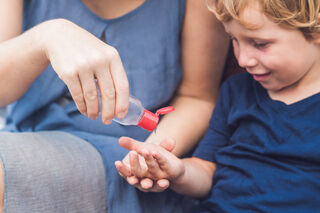Coronavirus Disease 2019
The Summer of COVID-19
Three signposts that can help us navigate the tricky transition.
Posted June 30, 2020

A couple of days ago my 6-year-old asked, “Is it summer yet?”
“You mean the official season? Yes, it started a bit over a week ago, on June 20th.”
He looked pensive. “No,” he said slowly. “I mean, like, summer. Like when there’s no school and we go swimming and stuff.”
The transition to summer looks, and feels, quite different this year. On the one hand, it doesn’t feel like much of a transition at all. School — or, rather, remote learning — ended, by necessity, with a whimper, rather than the usual bang. There haven’t been any kick-off-to-summer barbecues, pool openings, or beach bonfires. There can’t be. As we’ve continued to say, almost as a battle cry, in our house, all “because of stupid Coronavirus.”
And yet, this strange transition is a transition nonetheless, no matter how subtle. Many camps will start soon, albeit with various restrictions in place. Many playgrounds are now open. With remote learning a thing of the past (at least for now), parents are eager for other structures and routines with which to organize our children’s days. We are eager for our children to socialize with their peers. We are eager for child care.
Within this context, how do we begin to determine what’s safe and healthy, not only when it comes to the spread of COVID-19, but also with regard to the social and emotional development and mental health of our children? Unfortunately — and as is so often the case when it comes to raising children — there is no algorithm. There are, however, three signposts that can help guide us as we navigate these complicated and difficult decisions.
1. When it comes to planning your summer, there is no one-size-fits-all. Of course, on some level, this is obvious. All children are different, and even two children within the same family can have vastly different temperaments, personalities, and needs. And yet, within the past few weeks, I have had so many clients attempt to make decisions for their children based on what their neighbors, or even members of their favorite online community, are doing.
One mother bemoaned, “Everyone else is sending their children to camp this summer; am I a horrible mom because I really don’t want to take the risk?” Another had the exact opposite question: “All of my son’s friends seem to be perfectly OK entertaining themselves this summer, but I feel like my son is really struggling in the absence of interaction with his peers. Am I foolish for even considering camp right now?”
Of course, neither of these mothers is horrible, and neither is foolish. None of us are. We’re simply trying to do the best we can for our kids in the absence of any clear “right answer.” Sure, we have the general public health guidelines, but those don’t address the nuances of your family, your child.
When thinking about summer plans, think about — perhaps even write down — the factors that will influence your decision. Not the decision of the family down the street, or the mom on Instagram, but the family that you — and only you — are the expert on.
- Where does your family live? Are COVID-19 cases on the rise or on the decline?
- Who are the members of your family? Is anyone at particular risk, or is everyone generally pretty healthy?
- How has your child been doing during quarantine? Is he perfectly content to do his own thing, be on screens, have Zoom playdates? Or does his mood seem to be increasingly worse, more irritable, or more withdrawn?
- What other important factors are at play? Have you started having interaction with grandparents again? Would that have to change depending on the summer plans you make? If so, does that seem like a worthwhile trade-off?
Thinking methodically about these questions and issues will help inform the decision you make, the one that’s best for your child, family, and circumstances.
2. Take into account your own level of anxiety. I’ve said it before, I’ll say it again, and I’ll keep saying it: What your child needs most right now is a parent who is calm, and whose nervous system is regulated. Young children co-regulate with their caregivers, meaning, in simple terms, that they feed off of your energy and demeanor, even if you attempt to cover your true feelings (see my post about this exact issue here).
If you believe that sending your child off into the world right now is in his or her best interest (having undertaken the process described above), but you remain an anxious wreck about it, then, by all means, try to push yourself outside of your comfort zone — a little bit. Attempt some scientifically based relaxation strategies, perhaps seek some professional support. Then, if you’re still anxious, reconsider the decision you are making — at least at this moment in time — for your child.
Of course, I am not suggesting that you permanently bubble wrap your child to preserve your own mental health, always limiting their risk so that they don’t have to experience your discomfort. Right now though, when there’s so much uncertainty, it’s okay to prioritize your own regulated nervous system over your child’s expanding activity roster. In doing so, you’re not being selfish, but rather recognizing and accepting the extent to which your child currently needs you to be a steady force. Science has demonstrated again and again that a calm and regulated parent greatly increases the likelihood that children will be resilient in the face of stress.
3. Keep your expectations in check. As you navigate these difficult times, remember that no matter what path you choose, your child will likely experience some difficulty adjusting. Transitions take time, and you may see behaviors from your children that surprise you. You may be thrilled to be able to take your 4-year-old to the playground again, only to see that he is reluctant to get back on the equipment. Your 7-year-old may absolutely love her day camp — normally she’d be counting down the days — but now she is saying that she doesn’t want to be apart from you during the day.
Be sensitive to your children’s experiences. Go slow. Maybe you sit on the bench at the playground with your 4-year-old before you head toward the slide or swings. Maybe you give your 7-year-old a transitional object — one of your necklaces to wear, a photograph to carry — to take to camp, even though she hasn’t needed one since preschool.
Don’t panic. Your children are alright, they’re just adjusting to this new reality. Which is different from last month’s reality, and probably different from the reality we’ll be in a month from now. But they can do this. And so can you.




